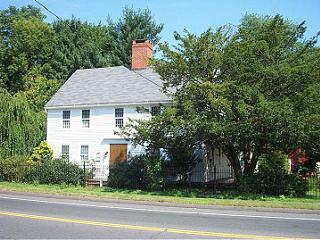Roger Butler House facts for kids
Quick facts for kids |
|
|
Roger Butler House
|
|
 |
|
| Location | 146 Jordan Lane, Wethersfield, Connecticut |
|---|---|
| Area | less than one acre |
| Built | c. 1769 |
| Architectural style | Colonial |
| NRHP reference No. | 96000847 |
| Added to NRHP | August 15, 1996 |
The Roger Butler House is a special old home in Wethersfield, Connecticut. It was built around 1769. This house is a great example of a style called Georgian architecture. It still looks much like it did long ago, except for its front door area, which was changed later. This historic house was added to the National Register of Historic Places on August 15, 1996.
Exploring the Roger Butler House
What Does the House Look Like?
The Roger Butler House stands on the north side of Jordan Lane. It is close to where Jordan Lane meets Wolcott Hill Road. A highway, the Wilbur Cross Parkway, runs behind the house. This gives the property a unique triangle shape.
The house is made of wood and has two and a half stories. It is wide, with five sections across the front. It has a large chimney in the middle of the roof. The main front door is also in the center. In the mid-1800s, porches were likely added to the side and back of the house.
The front entrance used to have a fancy cover called an Italianate hood. This has been removed. Now, the entrance looks simpler, more like the original Georgian style. Inside the house, many of the original floors, wooden details, and door handles are still there. This helps us imagine what life was like long ago.
A Look Back in Time
The Roger Butler House was built around 1769. It stayed in the same family, the Butler family, until 1954. The Butler family was very important in the Wethersfield area for a long time. The first family member, Deacon Richard Butler, arrived in 1633.
William Butler bought the land where this house stands in 1767. He probably built this house two years later. It was likely a wedding gift for his son, Roger. There's a local story that says the house was a stop on the Underground Railroad in the 1800s. The Underground Railroad was a secret network that helped enslaved people find freedom.



